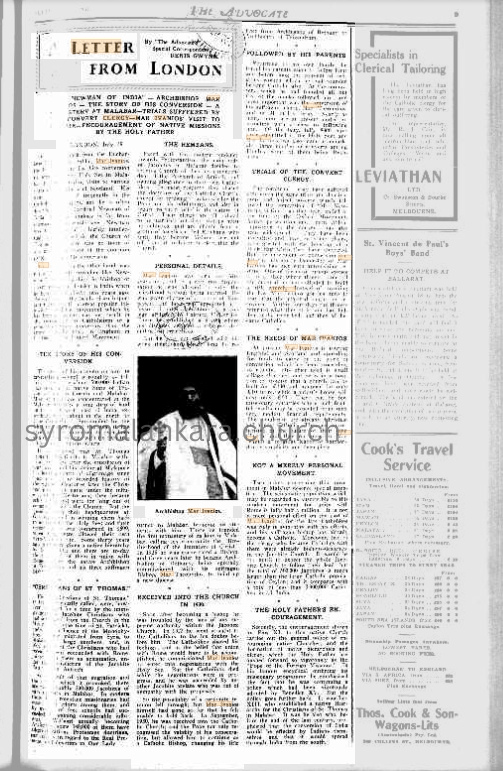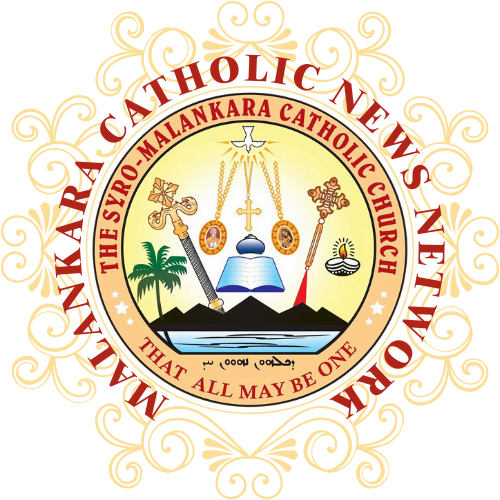“NEWMAN OF INDIA” — ARCHBISHOP MAR IVANIOS — THE STORY OF HIS CONVERSION — A MYSTERY AT MALABAR — TRIALS SUFFERED BY THE CONVERT CLERGY — MAR IVANIOS’ VISIT TO BRITAIN — ENCOURAGEMENT OF NATIVE MISSIONS BY THE HOLY FATHER.
LONDON, July 19.
Mutual movn: England. any great people tii re Mar Ivanios not a Uni> 0n his. v back from the Eucharistic Cont-r ,.= in Dublin, Mar Ivanios. the leader the Jacobite conversion to union whh the Holy See in Malabar, lias : paying visits to various parts of i.J;ind and Scotland. His name lw- :. :>oared frequently in the Catholic r,’ iispapers, and he is often describei; r, -.lie Cardinal Newman of India. B ‘ • ; lie analogy is far from representin: she whole case. was tlic U i.-lor of a highly Newman intellecciit within the Church of id there was no hope of .-inversion of the common .irii hi? conversion. in, nn the other hand, was fixity preacher like Newman, but ilie Jacobite Archbishop of a very important district in India when he became P. Catholic two years ago. He was one of the heads of an important Church with a great popular following. Ami the movement which ht lias brought about may yet result in the conversion to Catholicism of a population more numerous than the entire Catholic body in England in the time- of the Oxford Movement.
THE STORY OF HIS CONVERSION.
The’story of his conversion and its far-reaching sequel is roughly as follows: Time are about 500,000 Indian Jacobites in the native State of Travancore” aw! in Cochin and Malabar. Most of them are concentrated in the Malabar which is a long strip of land on the south-west coast of- India, extending from Calicut in the north to Cape Coiiimin. Surrounded by the Ghat mountains and the sea, it has developed very much on its own lines as a separate country with its own traditions and religious beliefs. It is believed that St. Thomas brought Christianity to Malabar within a few years after the crucifixion of Our Lord: and liis shrine at Mylapore has been ;t centre of pilgrimage since long before any recorded history of the region. Centuries later the Christian population came under the influence of the Nestorians; they became schismatic and were for long out of cominur.i.v.i with the Church. But the Jesuit?, with their headquarters at Goa, s«i;i (cried in winning them back to union with the Holy See; and their reconciliation was confirmed in 1599, when they were allowed their own Syro-\f;.lrih;>r rite. Some thirty years ago they were given a native hierarchy by Ler \ni.; and there are to-day about 5”i.OOO of them in union with Rome, r.irler the native Archbishop of Em A:,! urn and his three suffragan Bishop r, under ; sites. Malabo 1662, n recent! joined ” der t’i Patriar As the .sc’: :”CHRISTIANS OF ST. THOMAS.” Theivf. “Christians of St. Thomas,” as the;.- r.re usually called, were, howeve r >.aborted for a time by the immigration of Jacobite Christians who, had sep :: ated from the Church in the ntthcci..-ary (“the time of St. Patrick), ; influence of the Monophy- •iey migrated from Syria to • n large numbers; and, in •y of the Christians who had been reconciled with Rome ” ‘li them as schismatics, unurisdiction of the Jacobite • of Antioch. •suit of that migration and which it provoked, there are no v. roughly 500,000 Jacobites of Wious -orts in Malabar. In modern tpes t Protestant missionaries had £ ade f -at efforts among them, and oy 0f free schools ha<J suc. weded ,n gaining considerable influence Without actually becoming 7 1 ” s o m e 140,000 of them have aaoptecl various Protestant doctrines, Particular ly in regard to the Real Presence and devotion to Our -Lady:
THE REMBANS.
Faced with this modern tendency towards Protestantism, the main body of Jacobites in Malabar decided to set up a Church of their own, independent of the Patriarch of Antioch, and owning allegiance to their own Catholikos. In most rcspects they shared the doctrines of the Catholic” Church, except for refusing to acknowledge the Pope and his infallibilit}’. and also in regard to their belief in the nature of Christ. Their clergy are all obliged to be married; but their bishops must be celibates, and are chosen from a group of ascetics called Rembans, who until they become bishops are cut off from all ordinary work within the Church.
PERSONAL DETAILS.
Mar Ivanios was born just fifty years ago, and by a very rare dispensation he was allowed to enter the priesthood without being married. He was given charge of a school at Kottayam, and later appointed professor of palaeography at a college affiliated with Calcutta University. There he established a hostel where his disciples addressed themselves. But with work that could long he turned to Malabar, bringing his students with him. There he founded the first monastery of its kind in Malabar, calling his community the “Brotherhood of the Imitation of Christ.” In 1925 he was consecrated a Bishop, and three years later he became Archbishop of Bethany, being specially commissioned, with his suffragan Bishop, Mar Theophilos, to build up a new diocese.
RECEIVED INTO THE CHURCH IN 1930.
Soon after becoming a bishop he was troubled by the lack of any supreme authority within the Jacobite Church. In 1927 he went straight to the Catholikos to lay his doubts before him. The Catholikos shared his feelings; and in the belief that union with Rome would have to be accomplished, he commissioned Mar Ivanios to enter into negotiations with the Holy See. But the Catholikos died while the negotiations were in progress, and he was succeeded by another Jacobite prelate who was out of sympathy with the proposals. So the possibility of a corporate reunion fell through; but Mar. Ivanios himself had gone so far that he felt unable to hold back. In September, 1930, he was received into the Catholic Church; and the Pope not only recognized the validity of his consecration, but allowed him to continue as a Catholic Bishop, changing his title later from Archbishop of Bethany to Archbishop of Trivandrum.
FOLLOWED BY HIS PARENTS.
Returning to his own family, he found his parents eager to follow him; and before long the convent of religious women which he had founded became Catholic also. At the monastery which he had founded all but five of the monks followed him; and most important was the conversion of his suffragan bishop. Mar. Theophilos, and of 31 of his clergy. Nearly as many more are at present under instruction with a view to following him. Of the laity, fully 8000 have since submitted to the Holy See; and Mar Ivanios has also made a remarkably large number of converts among Hindus, some of them being Brahmins.
TRIALS OF THE CONVERT CLERGY.
The converted clergy have suffered very much the same trials and deprivations and abject poverty which followed the conversion of “Mr. Newman’s victims,” as they were called at the time of the Oxford Movement. Active persecution and even violent opposition to the converts has also been widespread. They have been boycotted and have, in some places, been greeted with the hoisting of a black flag when they have appeared. But the movement of conversion under the missionary leadership of Mar Ivanios has met with astonishing results. One of the most curious stories is of a place where thieves stole all the material he had collected to build a little church. Instead of invoking the law, Mar Ivanios got his nuns to pray that the material might be recovered. Within four days the thieves returned what they stole and had hidden in the river bed, and they all became Catholics.
THE NEEDS OF MAR IVANIOS.
At present Mar Ivanios is touring England and Scotland and appealing for funds to carry on the work of conversion, which has been proceeding so rapidly. His chief need is small village churches, and he is in a position to promise that a church can be built for £130 and equipped for only £10 more, while a priest’s house will cost only £60. There can be few missionary countries where such fruitful results may be expected from such very modest financial requirements. The population are already Christian and almost Catholic. They are apprehensive of the future of their own Church, and they recognize in Mar Ivanios a religious leader of extraordinary simplicity and deep piety.
NOT A MERELY PERSONAL MOVEMENT.
Two points concerning this movement in Malabar deserve special attention. The schismatic population which may be regarded as susceptible to this modern movement for unity with Rome is fully half a million. It is not a mere personal effort on the part of Mar Ivanios; for the late Catholikos was fully in sympathy with his efforts, and his suffragan bishop has already become a Catholic. Moreover, two of the clergy who became Catholics with them were already bishops-designate in the Jacobite Church. It would be too much to expect the whole Jacobite Church to follow their lead; but the total of 500,000 Jacobites is much larger than the large Catholic population of Ceylon; and it compares with a total of less than 2,900,000 Catholics in all India.
THE HOLY FATHER’S ENCOURAGEMENT.
Secondly, the encouragement shown by Pius XI. to this native Church carries out the general policy of encouraging native Churches, and the formation of native hierarchies and clergy, which the Holy Father has pushed forward so vigorously as the “Pope of the Foreign Missions.” In his famous encyclical outlining his missionary programme, he emphasized the fact that he was continuing a policy which had been vigorously adopted by Benedict XV. But the policy goes further back. It was Leo XIII. who established a native Hierarchy for the Christians of St. Thomas in Malabar. It was he also who, before the end of the last century, prophesied that the conversion of India would be effected by Indians themselves, and that it would spread through India from the south.
Copyright: The Advocate, 1 Sep 1932


